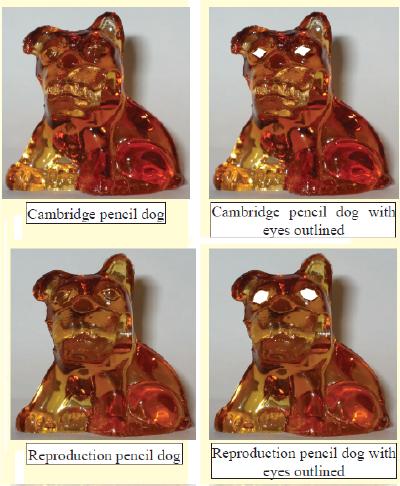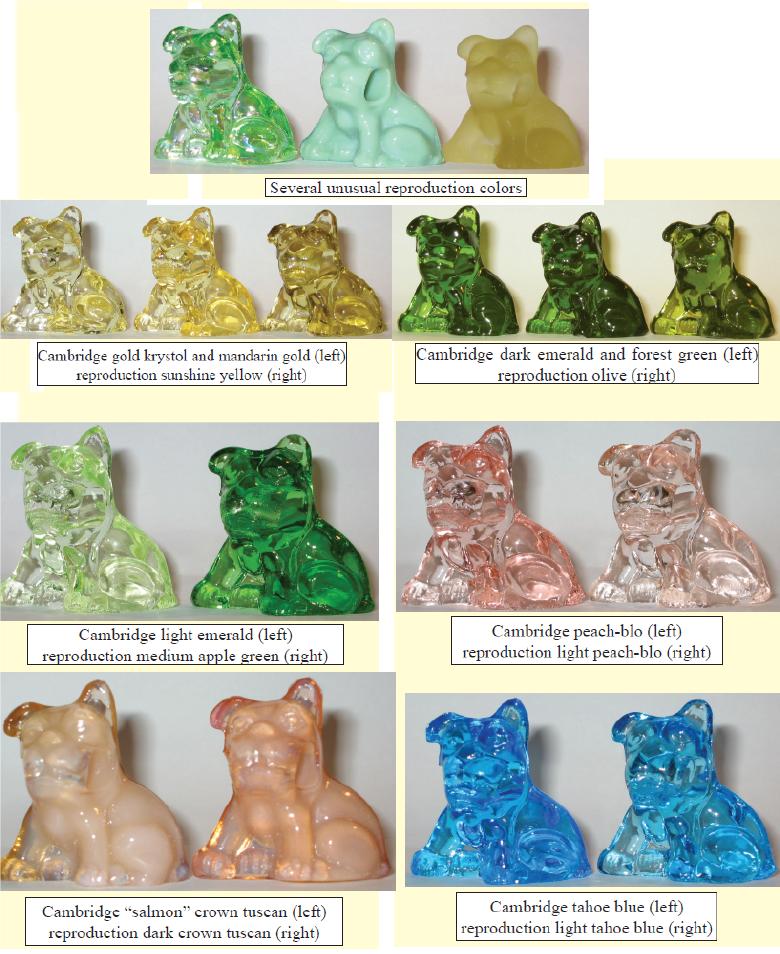Knowing Your Bridge Hounds
by Darren Swarts
Issue No. 455 - February 2012
Every Cambridge glass collector is familiar with the pencil dog. Having been reproduced extensively by Guernsey Glass, however, it can be difficult to distinguish an original from a reproduction even for an experienced collector. This article will detail various ways to accomplish this task.
Physical differences
between originals and
reproductions are easy to
spot even for a novice.
The mold used to make the
reproductions is rumored to
be a retooled Cambridge
one, but this idea is disputed
by some collectors. They
believe the reproduction
mold to be inspired by
the Cambridge one, rather
 than created from it. One
must first check for a "B"
mark between the legs in the
back. If present, then the dog is positively a reproduction.
than created from it. One
must first check for a "B"
mark between the legs in the
back. If present, then the dog is positively a reproduction.
Some reproductions, however, lack this definitive mark so other more subtle techniques must be employed. Next, one can check the dog's eyes. They are straight and horizontal on an original, but larger and slanted on a reproduction. The eyes, however, are not always present on originals or reproductions so other techniques may need to be used. One can check the crease between the front legs and feet and the inside of the front leg. Several small bumps of excess glass on the crease strongly indicate a reproduction; roughness on the inside of the front leg also strongly indicates a reproduction. Any hole-less dog is almost certainly a reproduction—the only possible exception being crystal. On an antidotal note, a stunted upright ear that leans backwards and lacks a mold line is typically seen on reproductions. However, the lack of a mold line does not disqualify a pencil dog from being an original, but rather later production.
Understanding colors is also important in this endeavor. The Cambridge pencil dog was made in the following colors: peach-blo, three distinct variations of crown tuscan, carmen, mocha, light amber, dark amber, gold krystol, mandarin gold, pistachio, light emerald, dark emerald, forest green, moonlight blue, tahoe blue, royal blue, mulberry, light amethyst, amethyst, smoke, ebony, milk, and crystal.
The reproduction pencil dog was also made in a variety of colors, which I will attempt to describe here. The pinks include light peach-blo and three distinct variations of crown tuscan. The reds vary from carmen to blood red, including subtle variations between the two. The ambers vary from light amber to dark amber to extremely dark amber, including variations between the former two. The yellows include sunshine yellow and vaseline. The greens include medium apple green and olive. The blues vary from moonlight blue to light tahoe blue to colonial blue to royal blue, including subtle variations between the latter two, a dark muted blue, and green-tinted windsor blue. The purples include heatherbloom and dark muted purple. The blacks include light smoke and ebony. Miscellaneous colors include milk and crystal. Special treatments include satin dark amber, satin sunshine yellow, satin medium apple green, satin milk, satin crystal, satin amber/milk slag, carnival light green, blue/green slag, and amber/milk slag. There are likely other colors, especially slag colors, that the author is currently unaware of.
Color differences between originals and reproductions may be used by more experienced collectors to differentiate the two. Original peach-blo is a stronger color than the reproduction light peach-blo. Original dark crown tuscan, or salmon, does not tend toward red as does the reproduction. Cambridge gold krystol and mandarin gold are both much brighter colors than the reproduction sunshine yellow. Cambridge pistachio and light emerald are much paler colors than the reproduction medium apple green. Neither Cambridge dark emerald nor forest green tend toward yellow to the extent reproduction olive does. Cambridge tahoe blue is darker and pools thicker than the reproduction light tahoe blue. Cambridge amethyst is much richer and pools thicker than the reproduction dark muted purple. Cambridge smoke pools thicker and does not tend toward yellow like the reproduction light smoke.
However, medium crown tuscan, carmen, light amber, dark amber, moonlight blue, royal blue, ebony, milk, and crystal are extremely difficult to tell apart.
Hopefully the reader finds the information and techniques contained in this article useful in their glass hunting. While every attempt has been made to ensure this article is complete as possible, as every glass collector knows, there is always something new to find. As such, any additional information is appreciated.

